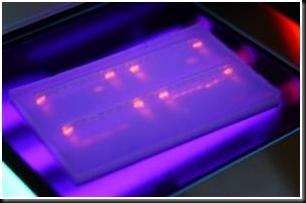Microbial forensics may help exonerate or incriminate much like DNA can
The anthrax killer spurred a whole new branch of science that could give the United States a head start in the next emergency — whether it is investigating more bioterrorism or even a food poisoning outbreak. It is called microbial forensics, a way of using a germ's genetics to help exonerate or incriminate much as human DNA can today.
Microbes — whether bacteria like Salmonella and E. coli, or viruses like HIV — have unique genetic signatures that can allow scientists to tell even the most closely related strains apart. The forensics side comes from adding crime-investigation techniques to this advanced microbiology used by disease detectives.
With anthrax, that science led to a single flask of bacteria deemed the genetic parent of the spores grown for the 2001 attacks. It then took traditional gumshoe detective work for the FBI to finger the flask's owner, Dr. Bruce Ivins, as the alleged attacker while ruling out others who shared his Fort Detrick laboratory where that flask was stored.
If tracing a single vial of germs sounds impressive, consider: Research under way now might one day allow tracing where someone has recently traveled by the DNA of bacteria in the dirt on their shoes.But microbial forensics is a fledgling field, apparently used in court only once before — in the attempted-murder conviction of a doctor who injected a former lover with HIV taken from one of his patients.
The far more complicated anthrax case could prove pivotal in establishing the credibility of microbial forensics, even though Ivins' suicide means it won't go to court. Thus, scientists are clamoring to see the full evidence. The FBI has not yet released the actual genetic test results, although bits of the work have been published in scientific journals.
"Science is a wonderful thing but it is, at the end of the day, a tool," said Dr. Gigi Gronvall of the University of Pittsburgh's Center for Biosecurity. "The question is how that was used." Microbial forensics is "still a field very much in its infancy," said prominent gene researcher Dr. Claire Fraser-Liggett, whose former laboratory, the Institute for Human Genome Research, was tapped by the FBI to perform extensive anthrax testing. "There was always the lingering question as to whether you would ever really be able to find differences that would be useful in terms of doing attribution."
While the Federal Bureau of Investigation prohibited Fraser-Liggett from disclosing specifics, the investigation ultimately compared DNA from more than 1,000 anthrax samples, "finding that you could really apply many of the same parallels with human forensics to microbial forensics," she said.The implications, she added, "go very far beyond just this one case."
Unlike in 2001, today the genetic makeup of many bacteria and viruses has been fully sequenced, or decoded, and advanced machinery makes it possible to sequence more samples in a day or two, for under $1,000 each. So Fraser-Liggett urges development of a database of multiple samples of pathogens collected from around the world, so the next such investigation won't have to start from scratch.
"My recommendation would clearly be to not wait until something happens again, because it may not be with anthrax," she said. Bioterrorism aside, such testing could trace culprits in food poisonings and other outbreaks more precisely than today's more limited genetic fingerprinting, she added. But legally, microbial forensics raises enough issues that in 2004, the FBI created an elite committee of specialists in genetics and law enforcement to develop the first guidelines on how to handle and preserve bacteria or viruses that may be part of a crime.
In the anthrax case, simpler testing rapidly showed the attack bacteria was the so-called Ames strain, widely used in laboratory research. Summaries released by the FBI this week said fuller gene sequencing uncovered four specific mutations that gave the anthrax a unique signature. When compared to 1,000 Ames samples from 16 laboratories, only the germs in Ivins' flask matched. Scientists' top question: Were enough samples tested to be sure another source wasn't missed?
"Frankly, I have some level of skepticism," said Dr. Philip Russell, the U.S. Department of Health and Human Services emergency preparedness chief in 2001. He suggested an outside panel such as the National Academy of Sciences review the evidence. "They've got a heavy lift to convince the scientific world they've nailed it." Dr. Francis Collins, former genetics chief at the National Institutes of Health, wants to see complete sequences for each sample — from the first victim, the four letters, the flask, and the ruled-out supplies — and would check testing quality. Labs that repeat the sequencing multiple times can reduce the chance of error to one in a million or less, he said.
More information about the apparently unique mutations is a key, added Dr. Michael Stebbins, who directs the Federation of American Scientists' biosecurity project. Did they arise naturally when Ivins first grew his anthrax supply in 1997, or did he engineer them? "If they were engineered by Dr. Ivins, it's highly unlikely that they would pop up anywhere else," Stebbins said. "Their case hinges on the fact that these strains came out of this particular flask."
Source:Msnbc


No comments:
Post a Comment